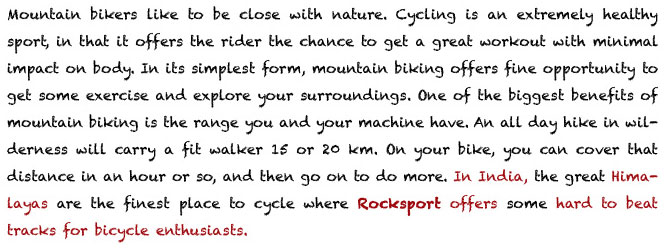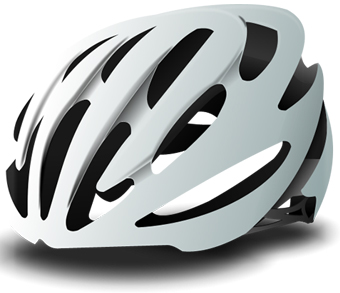Aboard a bike. Sport a smile. And your adrenaline therapy begins.
Mud? Water? Dirt? Bad weather? No problem. Just strap on your helmet and head down hill. You will find adventure with every ride!

Mountain Biking allows riders to challenge themselves on difficulties that require skill to negotiate. You can ride a mountain bike on mountain trails, over every rock and root, slosh through mud and water, skim across ice, through woods and fields, during all kinds of weather, and over any terrain. Mountain biking has it all - speed, thrill, and freedom.

No single person invented mountain biking. In the early 1970’s, a group of riders took their regular bikes off road in Marin County, California. Their hobby soon turned into a worldwide craze.


Mountain Biking has split into many different styles. You can ride cross country, downhill, and on the street. You can take part in Bicycle Super cross, dirt jumping, trials and races.
Cross country:
Cross country racing is arguably the purest and most physically demanding of the mountain biking disciplines. Racing normally takes on a short circuit, usually 6-7kms in length. The course has hill climbs, downhill sections, and single tracks. Cross country tracks are narrow with plenty of bumps. This form of racing is Olympic sport.
Downhill:
Downhill racing developed from cross country. The races last no longer than six minutes. The riders race against the clock on a rocky course.
Bicycle Supercross:
In bicycle supercross, or duel racing, riders race against each other over a short course. Similar to a BMX track, the route has many jumps. This is a tough and highly competitive form of mountain biking.
Dirt Jumping:
Riders often jump their bikes off road. On dirt jump trails, riders hurdle sets of human-made jumps. They let go of their bikes, spin, and even flip as they jump.
Trials:
In a mountain bike trial, riders test their balance. They hop and jump their bikes over a specially designed course. They try not to put a foot down while riding through the obstacles of the course.

Always wear a helmet when mountain biking. Other safety gear includes knee pads, gloves, shin guards and elbow pads. Mountain bike frames are built tough to handle all terrain. Some models have special springs or shock absorbers that help cushion the impacts of bumps and stumps while you are trail riding. A mountain bike has thick tires that can take you nearly anywhere as long as your legs can pedal you. Choose colourful biking clothing so that others can see you. Bring water with you for the ride. Pack extra clothes, snacks, or energy bars in saddle bags attached to your bike. Don’t forget to pack a first aid kit – and a spare inner tube.


Cycling is an extremely healthy sport, in that it offers the rider the chance to get a great workout with minimal impact on body. In India, the Great Himalayas are the finest place to cycle where Rocksport offers some hard to beat tracks for bicycle enthusiasts. In its simplest form, mountain biking offers fine opportunity to get some exercise and explore your surroundings. One of the biggest benefits of mountain biking is the range you and your machine have. An all day hike in wilderness will carry a fit walker 15 or 20 km. On your bike, you can cover that distance in an hour or so, and then go on to do more. Mountain bikers like to be close with nature.



Products
Safety Assistance Adventure Theme Parties Adventure Activities in Events Adventure for Media Adventure for Learning Leadership Camp for Students Artificial Climbing Wall Obstacle CourseActivities
White Water Rafting Zorbing Paint Ball Parasailing Rappelling Jeep Safari Mountain Biking Hot Air Ballooning Backpacking Pressure Rocket Rock Climbing Survival TrainingContact Us
Great Rocksport Private Limited Head Office:
21, Level 2, Shivaji Marg,
Facing Rama Road,
New Delhi, 110015
Tel:+91 11 450 985 37/450 418 10
Helpline: +91 9311 398 050
Copyright © rocksportadventures.com




